Ahmed Abdeldjallil DJELLAB

Machine Learning enthusiast
Data Science Master student
View My LinkedIn Profile
Deep Learning & Art: Neural Style Transfer
import os
import sys
import scipy.io
import scipy.misc
import matplotlib.pyplot as plt
from matplotlib.pyplot import imshow
from PIL import Image
import numpy as np
import tensorflow as tf
from tensorflow.python.framework.ops import EagerTensor
import pprint
%matplotlib inline
tf.random.set_seed(272) # DO NOT CHANGE THIS VALUE
pp = pprint.PrettyPrinter(indent=4)
img_size = 400
vgg = tf.keras.applications.VGG19(include_top=False,
input_shape=(img_size, img_size, 3),
weights='pretrained-model/vgg19_weights_tf_dim_ordering_tf_kernels_notop.h5')
vgg.trainable = False
pp.pprint(vgg)
<keras.engine.functional.Functional object at 0x0000015C44F122E0>
content_image = Image.open("images/louvre.jpg")
print("The content image (C) shows the Louvre museum's pyramid surrounded by old Paris buildings, against a sunny sky with a few clouds.")
content_image
The content image (C) shows the Louvre museum's pyramid surrounded by old Paris buildings, against a sunny sky with a few clouds.

def compute_content_cost(content_output, generated_output):
"""
Computes the content cost
Arguments:
a_C -- tensor of dimension (1, n_H, n_W, n_C), hidden layer activations representing content of the image C
a_G -- tensor of dimension (1, n_H, n_W, n_C), hidden layer activations representing content of the image G
Returns:
J_content -- scalar that you compute using equation 1 above.
"""
a_C = content_output[-1]
a_G = generated_output[-1]
# Retrieve dimensions from a_G
m, n_H, n_W, n_C = a_G.get_shape().as_list()
# Reshape a_C and a_G
a_C_unrolled = tf.reshape(a_C, shape=[m, n_H * n_W, n_C]) # Or tf.reshape(a_C, shape=[m, -1 , n_C])
a_G_unrolled = tf.reshape(a_G, shape=[m, n_H * n_W, n_C]) # Or tf.reshape(a_G, shape=[m, -1 , n_C])
# compute the cost with tensorflow
J_content = tf.reduce_sum(tf.square(a_C_unrolled - a_G_unrolled))/(4.0 * n_H * n_W * n_C)
return J_content
example = Image.open("images/monet_800600.jpg")
example

def gram_matrix(A):
"""
Argument:
A -- matrix of shape (n_C, n_H*n_W)
Returns:
GA -- Gram matrix of A, of shape (n_C, n_C)
"""
GA = tf.matmul(A, tf.transpose(A))
return GA
def compute_layer_style_cost(a_S, a_G):
"""
Arguments:
a_S -- tensor of dimension (1, n_H, n_W, n_C), hidden layer activations representing style of the image S
a_G -- tensor of dimension (1, n_H, n_W, n_C), hidden layer activations representing style of the image G
Returns:
J_style_layer -- tensor representing a scalar value, style cost defined above by equation (2)
"""
# Retrieve dimensions from a_G (≈1 line)
m, n_H, n_W, n_C = a_G.get_shape().as_list()
# Reshape the images to have them of shape (n_C, n_H*n_W) (≈2 lines)
a_S = tf.transpose(tf.reshape(a_S, shape=[-1, n_C]))
# OR a_S = tf.transpose(tf.reshape(a_S, shape=[ n_H * n_W, n_C]))
a_G = tf.transpose(tf.reshape(a_G, shape=[-1, n_C]))
# Computing gram_matrices for both images S and G (≈2 lines)
GS = gram_matrix(a_S)
GG = gram_matrix(a_G)
# Computing the loss (≈1 line)
J_style_layer = tf.reduce_sum(tf.square(GS - GG))/(4.0 *(( n_H * n_W * n_C)**2))
return J_style_layer
vgg.summary()
Model: "vgg19"
_________________________________________________________________
Layer (type) Output Shape Param #
=================================================================
input_1 (InputLayer) [(None, 400, 400, 3)] 0
block1_conv1 (Conv2D) (None, 400, 400, 64) 1792
block1_conv2 (Conv2D) (None, 400, 400, 64) 36928
block1_pool (MaxPooling2D) (None, 200, 200, 64) 0
block2_conv1 (Conv2D) (None, 200, 200, 128) 73856
block2_conv2 (Conv2D) (None, 200, 200, 128) 147584
block2_pool (MaxPooling2D) (None, 100, 100, 128) 0
block3_conv1 (Conv2D) (None, 100, 100, 256) 295168
block3_conv2 (Conv2D) (None, 100, 100, 256) 590080
block3_conv3 (Conv2D) (None, 100, 100, 256) 590080
block3_conv4 (Conv2D) (None, 100, 100, 256) 590080
block3_pool (MaxPooling2D) (None, 50, 50, 256) 0
block4_conv1 (Conv2D) (None, 50, 50, 512) 1180160
block4_conv2 (Conv2D) (None, 50, 50, 512) 2359808
block4_conv3 (Conv2D) (None, 50, 50, 512) 2359808
block4_conv4 (Conv2D) (None, 50, 50, 512) 2359808
block4_pool (MaxPooling2D) (None, 25, 25, 512) 0
block5_conv1 (Conv2D) (None, 25, 25, 512) 2359808
block5_conv2 (Conv2D) (None, 25, 25, 512) 2359808
block5_conv3 (Conv2D) (None, 25, 25, 512) 2359808
block5_conv4 (Conv2D) (None, 25, 25, 512) 2359808
block5_pool (MaxPooling2D) (None, 12, 12, 512) 0
=================================================================
Total params: 20,024,384
Trainable params: 0
Non-trainable params: 20,024,384
_________________________________________________________________
for layer in vgg.layers:
print(layer.name)
input_1
block1_conv1
block1_conv2
block1_pool
block2_conv1
block2_conv2
block2_pool
block3_conv1
block3_conv2
block3_conv3
block3_conv4
block3_pool
block4_conv1
block4_conv2
block4_conv3
block4_conv4
block4_pool
block5_conv1
block5_conv2
block5_conv3
block5_conv4
block5_pool
vgg.get_layer('block5_conv4').output
<KerasTensor: shape=(None, 25, 25, 512) dtype=float32 (created by layer 'block5_conv4')>
STYLE_LAYERS = [
('block1_conv1', 0.2),
('block2_conv1', 0.2),
('block3_conv1', 0.2),
('block4_conv1', 0.2),
('block5_conv1', 0.2)]
def compute_style_cost(style_image_output, generated_image_output, STYLE_LAYERS=STYLE_LAYERS):
"""
Computes the overall style cost from several chosen layers
Arguments:
style_image_output -- our tensorflow model
generated_image_output --
STYLE_LAYERS -- A python list containing:
- the names of the layers we would like to extract style from
- a coefficient for each of them
Returns:
J_style -- tensor representing a scalar value, style cost defined above by equation (2)
"""
# initialize the overall style cost
J_style = 0
# Set a_S to be the hidden layer activation from the layer we have selected.
# The last element of the array contains the content layer image, which must not be used.
a_S = style_image_output[:-1]
# Set a_G to be the output of the choosen hidden layers.
# The last element of the list contains the content layer image which must not be used.
a_G = generated_image_output[:-1]
for i, weight in zip(range(len(a_S)), STYLE_LAYERS):
# Compute style_cost for the current layer
J_style_layer = compute_layer_style_cost(a_S[i], a_G[i])
# Add weight * J_style_layer of this layer to overall style cost
J_style += weight[1] * J_style_layer
return J_style
@tf.function()
def total_cost(J_content, J_style, alpha = 10, beta = 40):
"""
Computes the total cost function
Arguments:
J_content -- content cost coded above
J_style -- style cost coded above
alpha -- hyperparameter weighting the importance of the content cost
beta -- hyperparameter weighting the importance of the style cost
Returns:
J -- total cost as defined by the formula above.
"""
J = alpha * J_content + beta * J_style
return J
content_image = np.array(Image.open("images/louvre_small.jpg").resize((img_size, img_size)))
content_image = tf.constant(np.reshape(content_image, ((1,) + content_image.shape)))
print(content_image.shape)
imshow(content_image[0])
plt.show()
(1, 400, 400, 3)

style_image = np.array(Image.open("images/monet.jpg").resize((img_size, img_size)))
style_image = tf.constant(np.reshape(style_image, ((1,) + style_image.shape)))
print(style_image.shape)
imshow(style_image[0])
plt.show()
(1, 400, 400, 3)

generated_image = tf.Variable(tf.image.convert_image_dtype(content_image, tf.float32))
noise = tf.random.uniform(tf.shape(generated_image), -0.25, 0.25)
generated_image = tf.add(generated_image, noise)
generated_image = tf.clip_by_value(generated_image, clip_value_min=0.0, clip_value_max=1.0)
print(generated_image.shape)
imshow(generated_image.numpy()[0])
plt.show()
(1, 400, 400, 3)

Load Pre-trained VGG19 Model
Define a function which loads the VGG19 model and returns a list of the outputs for the middle layers.
def get_layer_outputs(vgg, layer_names):
""" Creates a vgg model that returns a list of intermediate output values."""
outputs = [vgg.get_layer(layer[0]).output for layer in layer_names]
model = tf.keras.Model([vgg.input], outputs)
return model
content_layer = [('block5_conv4', 1)]
vgg_model_outputs = get_layer_outputs(vgg, STYLE_LAYERS + content_layer)
content_target = vgg_model_outputs(content_image) # Content encoder
style_targets = vgg_model_outputs(style_image) # Style enconder
Compute Total Cost
# Assign the content image to be the input of the VGG model.
# Set a_C to be the hidden layer activation from the layer we have selected
preprocessed_content = tf.Variable(tf.image.convert_image_dtype(content_image, tf.float32))
a_C = vgg_model_outputs(preprocessed_content)
# Assign the input of the model to be the "style" image
preprocessed_style = tf.Variable(tf.image.convert_image_dtype(style_image, tf.float32))
a_S = vgg_model_outputs(preprocessed_style)
Below are the utils that you will need to display the images generated by the style transfer model.
def clip_0_1(image):
"""
Truncate all the pixels in the tensor to be between 0 and 1
Arguments:
image -- Tensor
J_style -- style cost coded above
Returns:
Tensor
"""
return tf.clip_by_value(image, clip_value_min=0.0, clip_value_max=1.0)
def tensor_to_image(tensor):
"""
Converts the given tensor into a PIL image
Arguments:
tensor -- Tensor
Returns:
Image: A PIL image
"""
tensor = tensor * 255
tensor = np.array(tensor, dtype=np.uint8)
if np.ndim(tensor) > 3:
assert tensor.shape[0] == 1
tensor = tensor[0]
return Image.fromarray(tensor)
Training_step
optimizer = tf.keras.optimizers.Adam(learning_rate=0.01)
@tf.function()
def train_step(generated_image, alpha = 10, beta = 40):
with tf.GradientTape() as tape:
# In this function you must use the precomputed encoded images a_S and a_C
# Compute a_G as the vgg_model_outputs for the current generated image
a_G = vgg_model_outputs(generated_image)
# Compute the style cost
J_style = compute_style_cost(a_S, a_G)
# Compute the content cost
J_content = compute_content_cost(a_C, a_G)
# Compute the total cost
J = total_cost(J_content, J_style,alpha = alpha, beta = beta)
grad = tape.gradient(J, generated_image)
optimizer.apply_gradients([(grad, generated_image)])
generated_image.assign(clip_0_1(generated_image))
return J
generated_image = tf.Variable(generated_image)
J1 = train_step(generated_image)
print(J1)
tf.Tensor(25525.793, shape=(), dtype=float32)
Train the Mode
print("Num GPUs Available: ", len(tf.config.list_physical_devices('GPU')))
Num GPUs Available: 1
# Show the generated image at some epochs
# Uncoment to reset the style transfer process. You will need to compile the train_step function agai
epochs = 2501
for i in range(epochs):
train_step(generated_image)
if i % 250 == 0:
print(f"Epoch {i} ")
if i % 250 == 0:
image = tensor_to_image(generated_image)
imshow(image)
image.save(f"output/image_{i}.jpg")
plt.show()
Epoch 0

Epoch 250
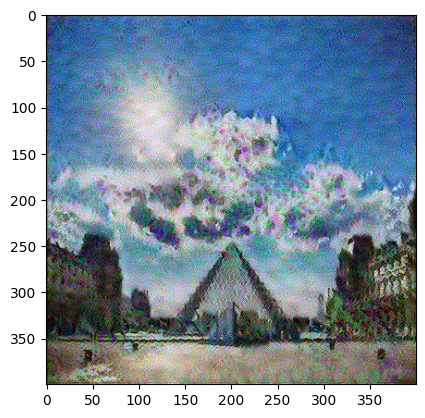
Epoch 500

Epoch 750
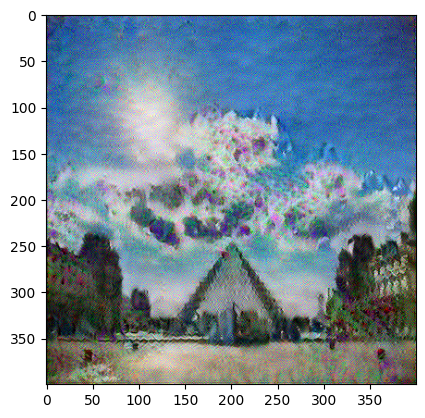
Epoch 1000

Epoch 1250
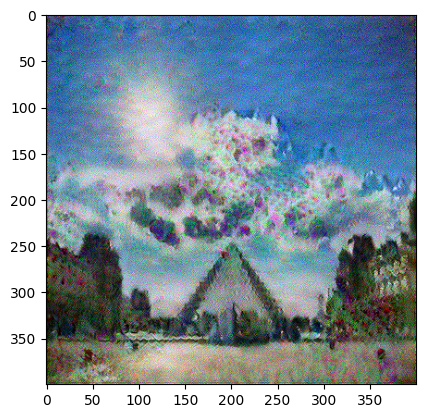
Epoch 1500
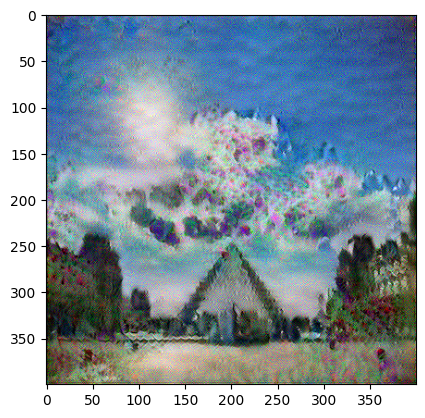
Epoch 1750

Epoch 2000
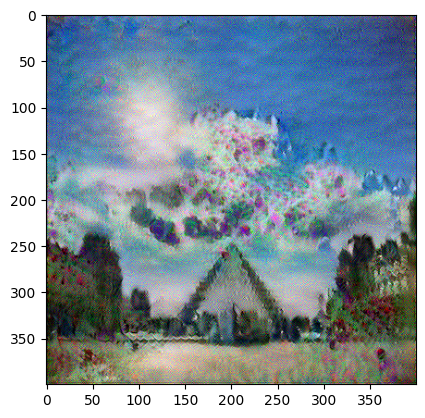
Epoch 2250
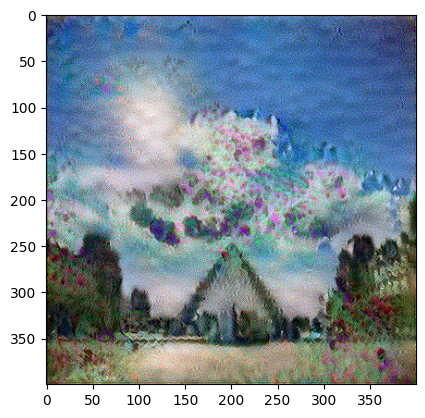
Epoch 2500
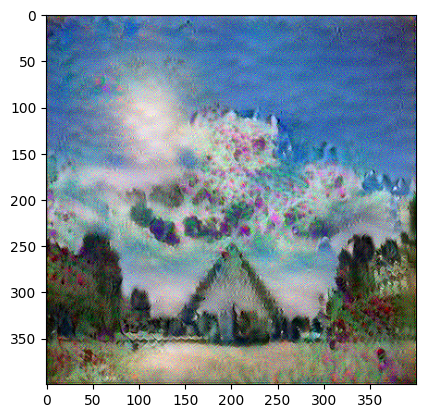
# Show the 3 images in a row
fig = plt.figure(figsize=(16, 4))
ax = fig.add_subplot(1, 3, 1)
imshow(content_image[0])
ax.title.set_text('Content image')
ax = fig.add_subplot(1, 3, 2)
imshow(style_image[0])
ax.title.set_text('Style image')
ax = fig.add_subplot(1, 3, 3)
imshow(generated_image[0])
ax.title.set_text('Generated image')
plt.show()
